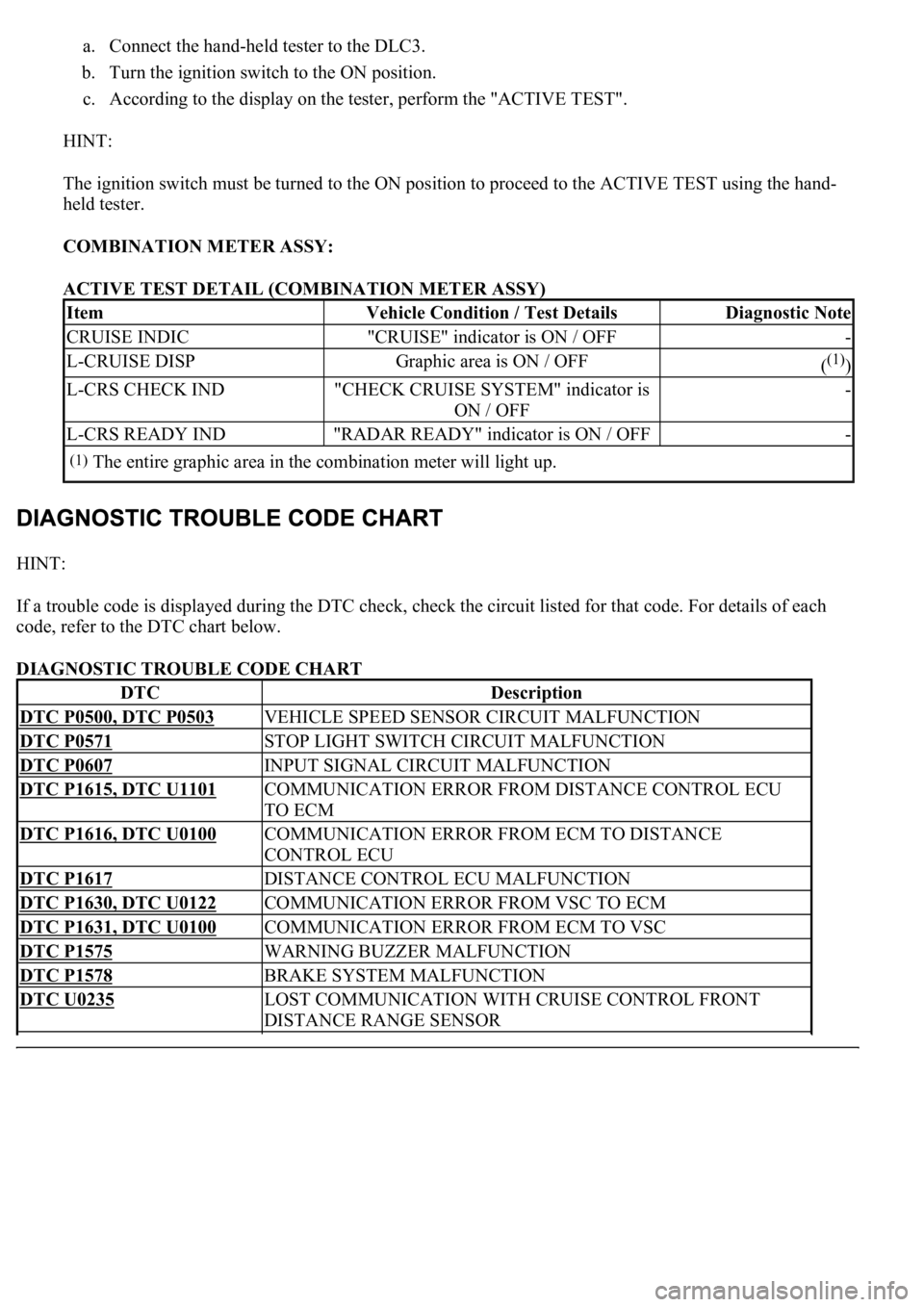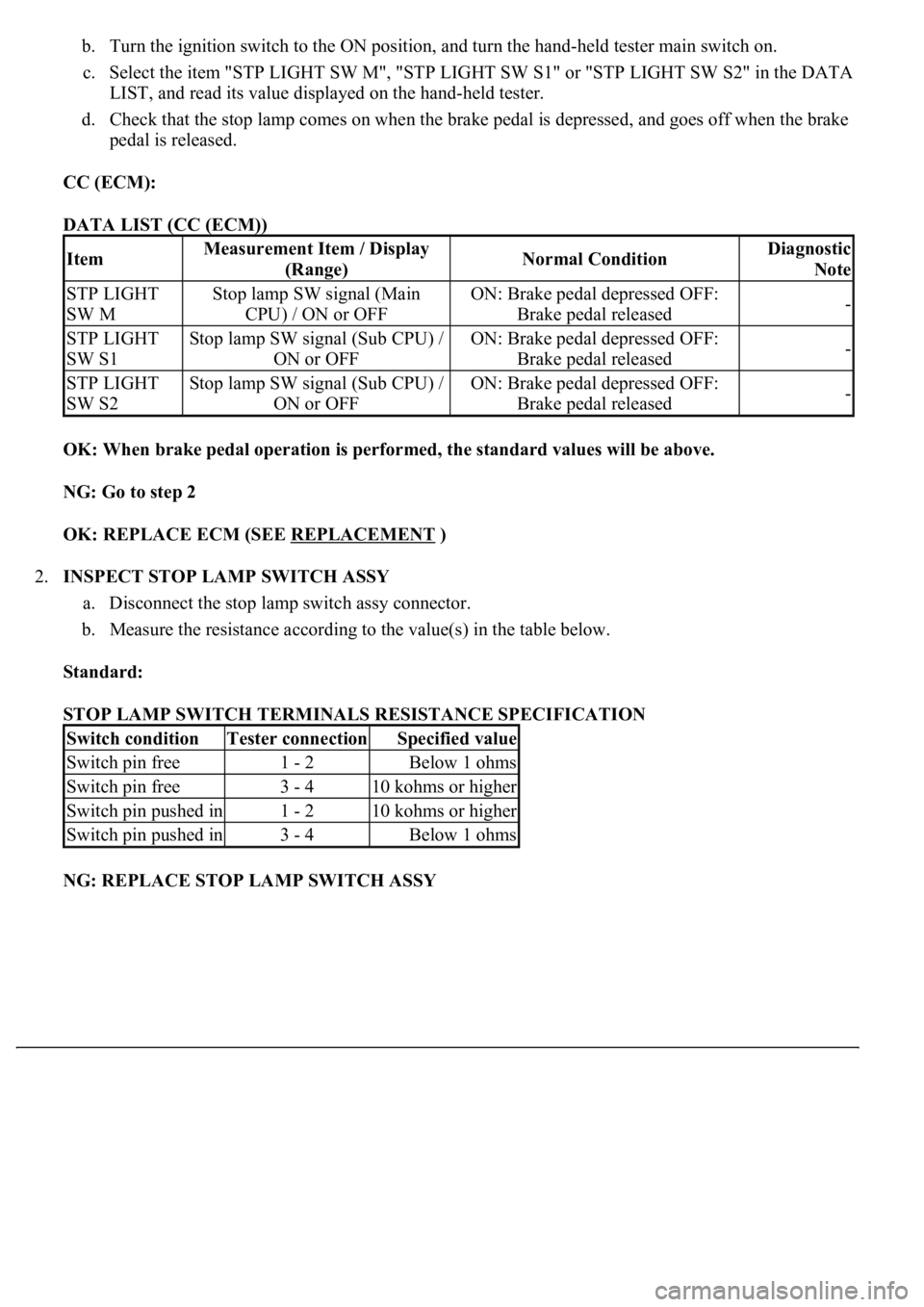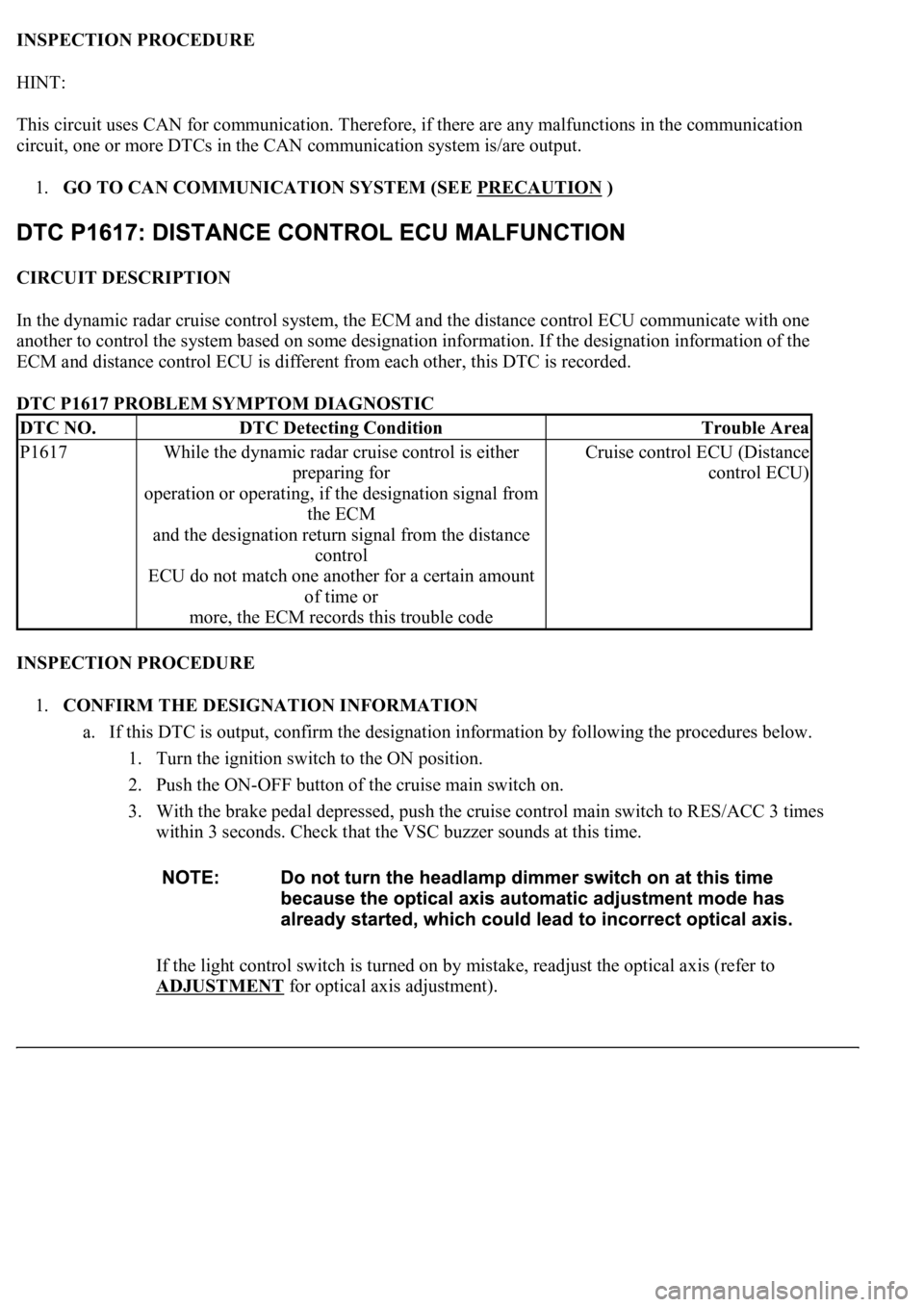Page 2563 of 4500
If a malfunction occurs in the vehicle speed sensors, the stop lamp switch, or other related parts during
cruise control driving, the ECU actuates AUTO CANCEL of the cruise control and blinks the CRUISE
main indicator light. This indicator light informs the driver of the malfunction. At the same time, the
malfunction is stored as a diagnostic trouble code.
Fig. 32: Identifying Blinking Pattern Of CRUISE Main Indicator Light
Courtesy of TOYOTA MOTOR SALES, U.S.A., INC.
1.DTC CHECK
a. Connect the hand-held tester to the DLC3.
b. Turn the ignition switch to the ON position.
c. Read the DTCs by following the prompts on the tester screen.
2.DTC CLEAR
a. Connect the hand-held tester to the DLC3.
b. Turn the ignition switch to the ON position.
c. Clear the DTCs following the prompts on the tester screen.
HINT:
Refer to the han
d-held tester operators manual for further details.
Page 2567 of 4500
1.DATA LIST
HINT:
From the DATA LIST displayed on the hand-held tester, the value of components such as the switch,
sensor, and actuator can be read without parts removal. Reading the DATA LIST as the first step of
troubleshooting is one way to shorten labor time.
a. Connect the hand-held tester to the DLC3.
b. Turn the ignition switch to the ON position.
c. According to the display on the tester, read the "DATA LIST".
CC (ECM):
Page 2570 of 4500

a. Connect the hand-held tester to the DLC3.
b. Turn the ignition switch to the ON position.
c. According to the display on the tester, perform the "ACTIVE TEST".
HINT:
The ignition switch must be turned to the ON position to proceed to the ACTIVE TEST using the hand-
held tester.
COMBINATION METER ASSY:
ACTIVE TEST DETAIL (COMBINATION METER ASSY)
HINT:
If a trouble code is displayed during the DTC check, check the circuit listed for that code. For details of each
code, refer to the DTC chart below.
DIAGNOSTIC TROUBLE CODE CHART
ItemVehicle Condition / Test DetailsDiagnostic Note
CRUISE INDIC"CRUISE" indicator is ON / OFF-
L-CRUISE DISPGraphic area is ON / OFF((1))
L-CRS CHECK IND"CHECK CRUISE SYSTEM" indicator is
ON / OFF-
L-CRS READY IND"RADAR READY" indicator is ON / OFF-
(1)The entire graphic area in the combination meter will light up.
DTCDescription
DTC P0500, DTC P0503VEHICLE SPEED SENSOR CIRCUIT MALFUNCTION
DTC P0571STOP LIGHT SWITCH CIRCUIT MALFUNCTION
DTC P0607INPUT SIGNAL CIRCUIT MALFUNCTION
DTC P1615, DTC U1101COMMUNICATION ERROR FROM DISTANCE CONTROL ECU
TO ECM
DTC P1616, DTC U0100COMMUNICATION ERROR FROM ECM TO DISTANCE
CONTROL ECU
DTC P1617DISTANCE CONTROL ECU MALFUNCTION
DTC P1630, DTC U0122COMMUNICATION ERROR FROM VSC TO ECM
DTC P1631, DTC U0100COMMUNICATION ERROR FROM ECM TO VSC
DTC P1575WARNING BUZZER MALFUNCTION
DTC P1578BRAKE SYSTEM MALFUNCTION
DTC U0235LOST COMMUNICATION WITH CRUISE CONTROL FRONT
DISTANCE RANGE SENSOR
Page 2576 of 4500

b. Turn the ignition switch to the ON position, and turn the hand-held tester main switch on.
c. Select the item "STP LIGHT SW M", "STP LIGHT SW S1" or "STP LIGHT SW S2" in the DATA
LIST, and read its value displayed on the hand-held tester.
d. Check that the stop lamp comes on when the brake pedal is depressed, and goes off when the brake
pedal is released.
CC (ECM):
DATA LIST (CC (ECM))
OK: When brake pedal operation is performed, the standard values will be above.
NG: Go to step 2
OK: REPLACE ECM (SEE REPLACEMENT
)
2.INSPECT STOP LAMP SWITCH ASSY
a. Disconnect the stop lamp switch assy connector.
b. Measure the resistance according to the value(s) in the table below.
Standard:
STOP LAMP SWITCH TERMINALS RESISTANCE SPECIFICATION
NG: REPLACE STOP LAMP SWITCH ASSY
ItemMeasurement Item / Display
(Range)Normal ConditionDiagnostic
Note
STP LIGHT
SW MStop lamp SW signal (Main
CPU) / ON or OFFON: Brake pedal depressed OFF:
Brake pedal released-
STP LIGHT
SW S1Stop lamp SW signal (Sub CPU) /
ON or OFFON: Brake pedal depressed OFF:
Brake pedal released-
STP LIGHT
SW S2Stop lamp SW signal (Sub CPU) /
ON or OFFON: Brake pedal depressed OFF:
Brake pedal released-
Switch conditionTester connectionSpecified value
Switch pin free1 - 2Below 1 ohms
Switch pin free3 - 410 kohms or higher
Switch pin pushed in1 - 210 kohms or higher
Switch pin pushed in3 - 4Below 1 ohms
Page 2577 of 4500
Fig. 47: Identifying Stop Lamp Switch Assy Connector
Courtesy of TOYOTA MOTOR SALES, U.S.A., INC.
OK: Go To Next Step.
3.CHECK HARNESS AND CONNECTOR (STOP LAMP SWITCH - BATTERY)
a. Measure the voltage according to the value(s) in the table below.
Standard:
STOP LAMP SWITCH TERMINALS VOLTAGE SPECIFICATION
Tester connectionConditionSpecified condition
S19-2 - Body groundAlways10 to 14V
S19-3 - Body groundIgnition SW ON10 to 14V
Page 2578 of 4500
Fig. 48: Identifying Stop Lamp Switch Assy Connector
Courtesy of TOYOTA MOTOR SALES, U.S.A., INC.
NG: REPAIR OR REPLACE HARNESS OR CONNECTOR
OK: Go To Next Step.
4.INSPECT ECM
a. Reconnect the stop lamp switch connector.
b. Disconnect the E2 and E3 connectors from the ECM.
c. Turn the ignition switch to the ON position.
d. Measure the voltage according to the value(s) in the table below.
Standard:
ECM CONNECTOR TERMINALS VOLTAGE SPECIFICATION
Pedal conditionTester connectionSpecification
DepressedE2-4 (STP) - Body ground10 to 14V
ReleasedE2-4 (STP) - Body groundBelow 1 V
Page 2583 of 4500
CIRCUIT DESCRIPTION
This DTC indicates a malfunction in the ECM.
HINT:
The ECM receives signals from each sensor to control all the functions of the cruise control with the
microcomputer.
When a malfunction is detected, fail-safe remains on until the ignition switch is turned off.
Fig. 52: DTC P0607 Problem Symptom Diagnostic Chart
Courtesy of TOYOTA MOTOR SALES, U.S.A., INC.
INSPECTION PROCEDURE
1.REPLACE ECM (SEE REPLACEMENT
)
CIRCUIT DESCRIPTION
The distance control ECU receives information about the area in front of the vehicle from the millimeter wave
radar sensor and then sends a brake control demand signal (deceleration demand) and diagnosis signals, such as
millimeter wave radar sensor grime or millimeter wave radar sensor malfunction, to the ECM.
Page 2585 of 4500

INSPECTION PROCEDURE
HINT:
This circuit uses CAN for communication. Therefore, if there are any malfunctions in the communication
circuit, one or more DTCs in the CAN communication system is/are output.
1.GO TO CAN COMMUNICATION SYSTEM (SEE PRECAUTION
)
CIRCUIT DESCRIPTION
In the dynamic radar cruise control system, the ECM and the distance control ECU communicate with one
another to control the system based on some designation information. If the designation information of the
ECM and distance control ECU is different from each other, this DTC is recorded.
DTC P1617 PROBLEM SYMPTOM DIAGNOSTIC
INSPECTION PROCEDURE
1.CONFIRM THE DESIGNATION INFORMATION
a. If this DTC is output, confirm the designation information by following the procedures below.
1. Turn the ignition switch to the ON position.
2. Push the ON-OFF button of the cruise main switch on.
3. With the brake pedal depressed, push the cruise control main switch to RES/ACC 3 times
within 3 seconds. Check that the VSC buzzer sounds at this time.
If the light control switch is turned on by mistake, readjust the optical axis (refer to
ADJUSTMENT
for optical axis adjustment).
DTC NO.DTC Detecting ConditionTrouble Area
P1617While the dynamic radar cruise control is either
preparing for
operation or operating, if the designation signal from
the ECM
and the designation return signal from the distance
control
ECU do not match one another for a certain amount
of time or
more, the ECM records this trouble codeCruise control ECU (Distance
control ECU)